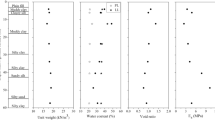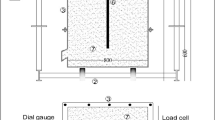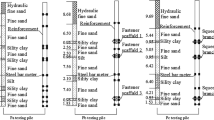Abstract
The pre-bored precast piling method is an efficient and environmental measure to construct precast piles to avoid squeezing effect, noise and vibration pollution. Although this pile has been increasingly used in China, the true ultimate bearing capacity and load transfer mechanism are still unclear. In this study, three full-scale ultimate static loading tests on instrumented pre-bored precast piles were conducted in Shanghai, China. The tests results indicated that the load-displacement curve increased slowly at the beginning, and tumbled sharply after reaching the ultimate resistance of the test piles. The pre-bored precast pile with enlarged base pertained to the type of typical end bearing friction pile. Axial force could be directly transferred to the pile toe at initial loading and the toe resistance accounted for about 25% of the pile capacity when applied ultimate load. It is concluded that the pre-bored precast pile with enlarged base in soft clay has a good axial bearing performance, and the ultimate static loading tests provide guidance and technical support for the theoretical research and engineering practice of these piles in Shanghai.
Access provided by CONRICYT-eBooks. Download conference paper PDF
Similar content being viewed by others
Keywords
1 Introduction
The pre-bored precast piling method is an efficient, environmental and economical measure to construct precast piles to avoid squeezing effect, noise and vibration pollution. It has been widely used in Japan for last decades, and some improved versions with enlarged base have been developed to meet the demand of the higher bearing capacity piles after 2004 (Yamato and Karkee 2004; Kobayashi and Ogura 2007). To adapt to different geological and construction conditions, a modified pre-bored precast pile with flexible composition of inner precast concrete piles and special dimension of enlarged base has been increasingly popular in China (Zhang et al. 2013).
The high vertical compressive bearing capacity of such piles has been confirmed by previous studies and applications (Karkee et al. 1998; Zhou et al. 2013). The load transfer mechanism of pile shaft and enlarged base were analyzed with laboratory model tests (Kusakabe et al. 1994; Ishikawa et al. 2011) and numerical simulation (Zhou et al. 2016). A limited number of well documented static loading tests on modified pre-bored precast piles are available in early literature (Zhou et al. 2013, 2015). However, all the above-mentioned field loading tests were the proof-load tests, which were terminated before reaching the true ultimate capacity of the test piles with plunging failure. As a result, it was unable to obtain the true ultimate bearing capacity and the distribution characteristics of ultimate shaft and toe resistance.
In this study, three full-scale ultimate static loading tests on pre-bored precast piles with enlarged base were conducted in Shanghai for the first time. The main purpose of the tests is to investigate the load-displacement response and load transfer mechanism of test piles.
2 Description of Modified Pre-bored Precast Piling Method
The basic sequence of pile installation is illustrated in Fig. 1. In this method, cement soil column with enlarged high strength base should be first formed using a special helical auger, then the precast concrete pile is inserted using self-weight. With the auger going up and down continually during construction process, base-forming and side-forming cement milks are injected into the soil and mixed well with the soil to increase the toe and shaft resistance of the pile. More importantly, the piling method has been developed to provide high bearing capacity from deeper and better stratum without much reliance on the shaft resistance of the upper soft soil layers (Yamato and Karkee 2004).
Installation sequence (modified after Zhang et al. 2013)
The inner concrete precast piles can be made up of prestressed high-strength concrete (PHC) pile, PHC nodular pile, prestressed reinforced high-strength concrete (PRHC) pile and so on. The composition of inner precast piles is flexible to achieve different requirements of load performance. The water-cement ratio of cement milk of pile shaft and enlarged base is about 1.0–1.2 and 0.6–0.7, respectively. The diameter of the enlarged base should not be more than 1.6 times the diameter of the borehole, and the height of base should not be less than 3 times the diameter of the borehole.
3 Pile Test Program
3.1 Ground Conditions
The test piles were located in the central area of Shanghai, China, famous for its thick layer of marine deposits. A series of laboratory and in situ tests were performed at this site. The groundwater table was located at a depth of 1.5 m. The subsurface condition mainly consists of mucky clay, silty clay, silt and silty sand. Soil parameters of different layers from laboratory tests are summarized in Table 1. The cohesion c and friction angle φ were determined from consolidated undrained tests, and modulus of compressibility Es worked under 100–200 kPa. The ultimate unit shaft resistance qsik and unit toe resistance qpk are recommended for precast piles in technical code DGJ0811 (2010).
3.2 Pile Installation and Instrumentation
Three test piles with length of 55 m and shaft diameter of 750 mm consisted of two parts of inner precast concrete piles, assembled by a 40 m long 600 mm diameter PHC pile section in the upper part and a 15 m long 650 mm (500 mm) diameter nodular pile in the lower part. The pile toes were all located in medium-dense silt mixed silty clay. The enlarged bases were 1200 mm diameter and 2750 mm long. According to the construction record, the cement ratio of pile shaft and enlarged base was 9.0% and 59.8%, respectively.
The test piles were instrumented with vibrating-wire strain gages at six different levels: 1.5, 18.0, 28.0, 39.0, 46.0, and 53.0 m from the pile head. Figure 2 shows the arrangement of the strain sensors along pile shaft. At each level, four gages were arranged in 90°. The gages in each pile were attached tightly to the spiral hoop steels of the precast concrete piles when constructed in the factory, as shown in Fig. 3. To minimize the effect of bending related strains, the average of the readings from the four strain gauges was adopted for analysis. The uppermost set of strain gages was deliberately placed at a distance of 1.5 m below the pile head to minimize the effects of localized stresses near the pile head (Lam and Jefferis 2011). To create the pile head suitable for the loading test, the upper 0.80 m of the pile was encased in a steel casing. To examine whether the strain gauges were affected during pile installation, strain values were monitored at three critical stages: in the construction site, immediately after pile forming, before the loading test.
3.3 Static Loading Test
Static loading tests were carried out 43–45 days after pile installation by the maintained load method, which was conducted in accordance with the Chinese code JGJ106 (2014). The test apparatus mainly consisted of a counterforce device using concrete blocks, a loading device using hydraulic jack, and a measuring system using force and displacement sensors, as shown in Fig. 4. All the test piles were designed to be loaded to reach the ultimate capacity of plunging failure and then fully unloaded. The load increment of 800 kN was equal to about 10% of the estimated maximum load. For each loading step, the pile head displacement was recorded at 5, 15, 30, 45, 60 min and every 30 min thereafter until the displacement rate reduced to a minimum value of 0.1 mm/h.
4 Pile Test Results
4.1 Load-Displacement Response
Figure 5 shows the measured load-displacement response of the three test piles. The load-displacement curves of TP1 and TP2 increased slowly at the beginning of loading, and then dropped dramatically when reaching the ultimate bearing capacity of the pile plunging failure of 8800 kN. As the pile head of TP3 was inclined during the test, the loading test on TP3 was terminated at applied load of 8000 kN. The ultimate bearing capacity of the three test piles was greater than the design requirement of 6700 kN. The pile head displacements of test piles were small during the initial stages of loading, and were less than 10 mm and 40 mm at working load of 4400 kN and ultimate load of 8800 kN, respectively. The displacement and applied load of pile head at several critical stages are summarized in Table 2.
4.2 Load Transfer Mechanism
Load Distribution.
The total axial force of test pile is equal to the axial force of the precast pile plus the axial force of the cement soil. The variation of cross sectional area and material composition along the pile axis was taken into account in computing the axial force. The Young’s modulus of cement soil of pile shaft and enlarged base were assumed equal to 160 MPa and 2500 MPa from testing results with similar conditions (Zhou et al. 2016). The nonlinear relationship of Young’s modulus of the inner precast concrete pile and measured strain was obtained from the strain data at the uppermost gauge level using the secant modulus method (Lam and Jefferis 2011). This relationship was applied to the other strain gage levels. In addition, the effects of residual loads were accounted for (Fellenius 2002).
The load distributions of the test piles were basically consistent. A typical load distribution of TP1 is illustrated in Fig. 6. Only very little difference of load distribution between the whole test pile and inner precast pile can be seen in Fig. 6(a) and (b). This indicated that the deformation performance of the pre-bored precast pile was mainly affected by the inner precast pile. Due to the high stiffness of the precast pile and reinforcement of pile toe with enlarged base, the axial force of the pile could be transferred directly to the pile toe at the initial stage of loading. This property was similar to that of long rock socketed pile (Wang et al. 2016). The axial force decreased with the increase of the buried depth, and the reinforcement effect of enlarged base was strengthened. The toe resistance accounted for about 25% of the applied load under the ultimate condition.
The Young’s modulus of cement soil was about 0.5% of the modulus of precast concrete pile, so the axial force of the cement soil of pile shaft could be neglected without larger errors, as shown in Fig. 6(c). However, the axial force of the cement soil at enlarged base obviously raised to 300–400 kN under ultimate conditions, which made up 15.2–19.5% of the toe resistance of test piles.
Mobilized Shaft Resistance.
According to previous engineering experience and numerical analysis (Zhou et al. 2016), the shaft resistance of pre-bored precast pile with enlarged base was dominated by the interface between cement soil and surrounding soil. The unit shaft resistance (τs) between two instrumented levels can be back-figured from the measured axial forces at different depths. On the whole, although the total shaft resistance increased during loading test, the proportion reduced from 88.0% to 75.0% under the ultimate conditions.
The typical mobilized unit shaft resistance of TP1 is shown in Fig. 7. The measured ultimate values (τmax) was about 30% higher than the recommended values in DGJ0811 (2010). The unit shaft resistance of upper and lower part of the test piles increased simultaneously. This was quite different from that of super long bored piles (Wang et al. 2011). With the increase of applied load, the upper shaft resistance between the depth of 1.5 to 28.0 m decreased to residual value (τres), with residual adhesion ratio (τres/τmax) approximately ranging from 0.70 to 0.90 after reaching the peak (τmax). However, the shaft resistance of lower part continued to increase until the end of the test.
Mobilized Toe Resistance.
The unit toe resistance can be obtained from the readings of the strain gauges near the pile toe. Field tests indicated that pre-bored precast pile with enlarged base was a typical end bearing friction pile. The unit toe resistance of test piles reached the ultimate values when the test piles reaching pile plunging failure. Generally, the unit toe resistance increased nonlinearly with the pile head loading, as shown in Fig. 8. As the applied load exceeded the ultimate value of 8800 kN, the unit toe resistance showed an accelerated growth. The ultimate unit toe resistance of test piles was about 1950 kPa, accounting for 55% of the recommended value for traditional precast pile in technical code DGJ0811 (2010).
5 Conclusions
A series of full-scale ultimate static loading tests were performed on three modified pre-bored precast piles with enlarged base installed in thick layer marine deposits in Shanghai, China. Some conclusions can be drawn as follows:
-
(1)
The ultimate bearing capacity of three pre-bored precast piles with enlarged base NO. TP1–TP3 met the requirement of the design criteria. This type of pile with higher bearing capacity was verified in thick soft soil area, which could replace the traditional bored piles and precast piles in some cases.
-
(2)
Field study indicated that pre-bored precast pile with enlarged base was a typical end bearing friction pile. The axial force of the pile could be transferred directly from pile head to pile toe at the initial loading stage, and the toe resistance was about 25% of the pile capacity when applied ultimate load.
-
(3)
The upper unit shaft resistance showed softening performance with the residual adhesion ratio ranging from 0.70 to 0.90, while the lower unit shaft resistance increased gradually until the end of the test. The unit toe resistance increased nonlinearly with the pile head loading, and the ultimate unit toe resistance accounted for 55% of the recommended value for traditional precast pile.
References
DGJ0811: Foundation Design Code. Shanghai Urban-Rural Construction and Traffic Committee, Shanghai (2010)
Fellenius, B.H.: Determining the resistance distribution in piles. Part 1: notes on shift of no-load reading and residual load. Geotech. News Mag. 20(2), 35–38 (2002)
Ishikawa, K., Ito, A., Ogura, H., Nagai, M.: Effect of strength and tip length of enlarged grouted base on bearing capacity of nodular pile. J. Struct. Constr. Eng. 76(670), 2107–2113 (2011). (in Japanese)
JGJ106: Technical Code for Testing of Building Foundation Piles. Ministry of Housing and Urban-Rural Development of the People’s Republic of China, Beijing (2014)
Karkee, M.B., Kanai, S., Horiguchi, T.: Quality assurance in bored PHC nodular piles through control of design capacity based on loading test data. In: Proceedings of the 7th International Conference and Exhibition, Piling and Deep Foundations, Vienna, Austria, vol. 1, no. 24, pp. 1–9 (1998)
Kobayashi, K., Ogura, H.: Vertical bearing capacity of bored pre-cast pile with enlarged base considering diameter of the enlarged excavation around pile toe. In: Advances in Deep Foundations: International Workshop on Recent Advances of Deep Foundations (IWDPF07), Yokosuka, Japan, 1–2 February 2007, pp. 277–283 (2007)
Kusakabe, O., Kakurai, M., Ueno, K., Kurachi, Y.: Structural capacity of precast piles with grouted base. J. Geotech. Eng. 120(8), 1289–1306 (1994)
Lam, C., Jefferis, S.A.: Critical assessment of pile modulus determination methods. Can. Geotech. J. 48(10), 1433–1448 (2011)
Wang, W.W., Li, Y.H., Wu, J.B.: Field loading tests on large-diameter and super-long bored piles of Shanghai Center Tower. Chin. J. Geotech. Eng. 33(12), 1817–1826 (2011). (in Chinese)
Wang, W.W., Wu, J.B., Nie, S.B.: Field loading tests on large-diameter super-long rock-socketed bored piles of the Wuhan Center Tower. J. Build. Struct. 37(6), 196–203 (2016). (in Chinese)
Yamato, S., Karkee, M.B.: Reliability based load transfer characteristics of bored precast piles equipped with grouted bulb in the pile toe region. Soils Found. 44(3), 57–68 (2004)
Zhang, R.H., Wu, L.L., Kong, Q.H.: Research and practice of JZGZ pile foundation. Chin. J. Geotech. Eng. 35(S2), 1200–1203 (2013). (in Chinese)
Zhou, J.J., Gong, X.N., Wang, K.H., Zhang, R.H.: A field study on the behavior of static drill rooted nodular piles with caps under compression. J. Zhejiang Univ. Sci. A 16(12), 951–963 (2015)
Zhou, J.J., Gong, X.N., Wang, K.H., Zhang, R.H., Yan, T.L.: A model test on the behavior of a static drill rooted nodular pile under compression. Mar. Georesour. Geotechnol. 34(3), 293–301 (2016)
Zhou, J.J., Wang, K.H., Gong, X.N., Zhang, R.H.: Bearing capacity and load transfer mechanism of a static drill rooted nodular pile in soft soil areas. J. Zhejiang Univ. Sci. A 14(10), 705–719 (2013)
Author information
Authors and Affiliations
Corresponding author
Editor information
Editors and Affiliations
Rights and permissions
Copyright information
© 2018 Springer Nature Singapore Pte Ltd.
About this paper
Cite this paper
Ling, Z., Wang, Wd., Wu, Jb., Yuan, Jy. (2018). Full-Scale Loading Test on Pre-bored Precast Pile with Enlarged Base in Shanghai. In: Qiu, T., Tiwari, B., Zhang, Z. (eds) Proceedings of GeoShanghai 2018 International Conference: Advances in Soil Dynamics and Foundation Engineering. GSIC 2018. Springer, Singapore. https://doi.org/10.1007/978-981-13-0131-5_69
Download citation
DOI: https://doi.org/10.1007/978-981-13-0131-5_69
Published:
Publisher Name: Springer, Singapore
Print ISBN: 978-981-13-0130-8
Online ISBN: 978-981-13-0131-5
eBook Packages: Earth and Environmental ScienceEarth and Environmental Science (R0)












